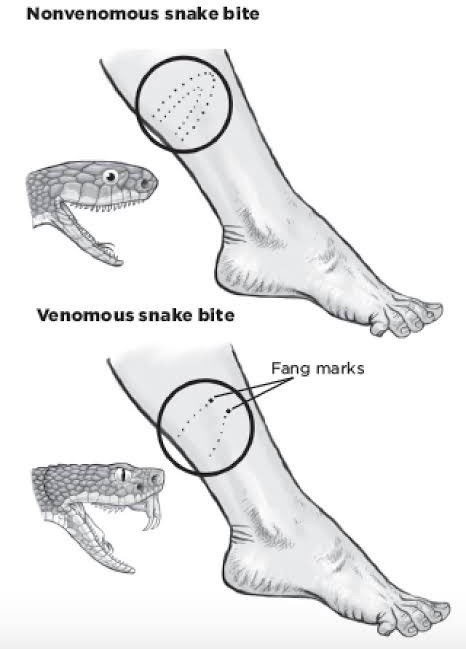A nurse in an emergency department is assessing a client who was biten on the left leg by a poisonous snake. The client has placed elastic bandages snugly above and below the bite marks and is in no apparent distress. Which of the following actions should the nurse take?
Remove both of the elastic bandages from the leg.
Discharge the client.
Obtain a prescription for the appropriate anti-venom.
Obtain a prescription for pain medication.
The Correct Answer is C
Choice A: Removing the elastic bandages is not recommended. These bandages help slow the spread of venom by compressing the lymphatic vessels. Removing them could worsen the envenomation.
Choice B: This is incorrect. The nurse should not discharge the client, as they may develop serious complications from the snake bite, such as swelling, bleeding, infection, or shock. The client should be monitored closely and treated accordingly.
Choice C: This is the correct action. Antivenom treatment is crucial for serious snake envenomation. The sooner it can be administered, the better the outcome.
Choice D: While pain management is important, it is not the priority in this situation. Antivenom takes precedence over pain medication.

Nursing Test Bank
Naxlex Comprehensive Predictor Exams
Related Questions
Correct Answer is A
Explanation
Choice A: Troponin I is a laboratory test that the nurse should anticipate the provider to prescribe. Troponin I is a protein that is released into the blood when the heart muscle is damaged. Troponin I levels are elevated in clients who have acute myocardial infarction (AMI), which is a heart atack caused by a blockage of blood flow to the heart. Chest pressure and shortness of breath are common signs and symptoms of AMI. Troponin I is a specific and sensitive marker of cardiac injury and can help diagnose AMI and guide treatment.
Choice B: Aspartate aminotransferase (AST) is not a laboratory test that the nurse should anticipate the provider to prescribe. AST is an enzyme that is found in various tissues, such as the liver, heart, skeletal muscle, and kidneys. AST levels are elevated in clients who have liver damage, hepatitis, cirrhosis, or alcohol abuse. AST levels can also be elevated in clients who have AMI, but they are not as specific or sensitive as troponin I. AST is not a reliable indicator of cardiac injury and can be influenced by other factors.
Choice C: B-type natriuretic peptide (BNP) is not a laboratory test that the nurse should anticipate the provider to prescribe. BNP is a hormone that is secreted by the heart when it is stretched or overloaded. BNP levels are elevated in clients who have heart failure, which is a condition in which the heart cannot pump enough blood to meet the
body's needs. Shortness of breath can be a sign of heart failure, but chest pressure is not. BNP is not a specific or sensitive marker of cardiac injury and can be influenced by other factors.
Choice D: Lipase is not a laboratory test that the nurse should anticipate the provider to prescribe. Lipase is an enzyme that is produced by the pancreas and helps digest fats. Lipase levels are elevated in clients who have pancreatitis, which is an inflammation of the pancreas. Pancreatitis can cause abdominal pain, nausea, vomiting, and fever. Chest pressure and shortness of breath are not signs of pancreatitis. Lipase is not a specific or sensitive marker of cardiac injury and has no relation to AMI.
Correct Answer is ["A","B","D","E"]
Explanation
Choice a) is correct because copies of insurance cards can help clients access medical care and claim compensation in case of a disaster. Insurance cards can also serve as a form of identification if other documents are lost or damaged.
Choice b) is correct because a whistle can help clients signal for help or locate each other in case of an emergency. A whistle can also deter potential atackers or wild animals.
Choice c) is incorrect because antibiotics are not recommended to be included in a disaster readiness supply kit or “go bag”. Antibiotics are prescription drugs that should only be used under the guidance of a health care provider. Using antibiotics without proper indication, dosage, or duration can cause adverse effects, such as allergic reactions, resistance, or superinfection.
Choice d) is correct because household bleach can be used to disinfect water, surfaces, or wounds in case of a disaster. Household bleach can also be used to create chlorine gas, which can be used as a weapon or a deterrent.
Choice e) is correct because pencil and paper can be used to write down important information, such as contact numbers, medical history, or evacuation plans. Pencil and paper can also be used to communicate with others, especially if there is no access to phone or internet services.
Whether you are a student looking to ace your exams or a practicing nurse seeking to enhance your expertise , our nursing education contents will empower you with the confidence and competence to make a difference in the lives of patients and become a respected leader in the healthcare field.
Visit Naxlex, invest in your future and unlock endless possibilities with our unparalleled nursing education contents today
Report Wrong Answer on the Current Question
Do you disagree with the answer? If yes, what is your expected answer? Explain.
Kindly be descriptive with the issue you are facing.
